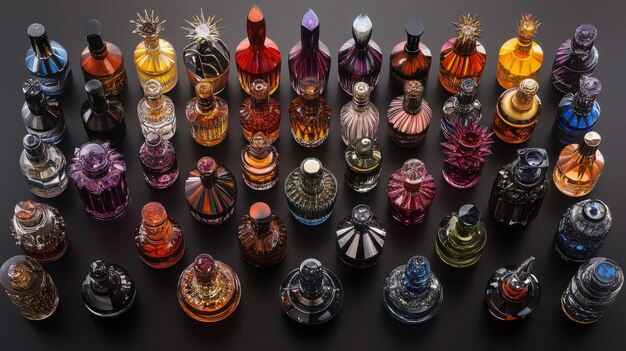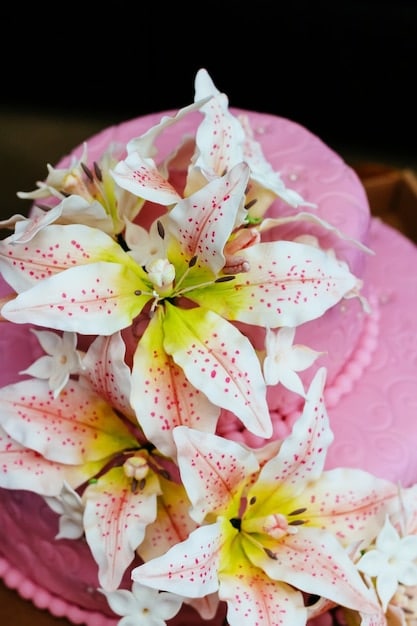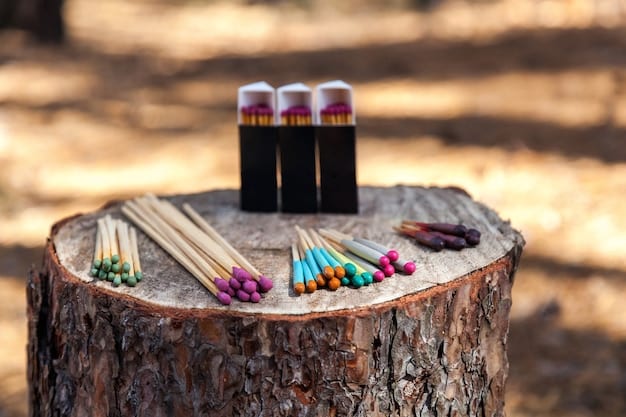Fragrance Families Explained: Find Your Perfect Scent in 2025

Fragrance families are categories that group scents based on shared characteristics, offering a framework for understanding and identifying your ideal scent profile in 2025, from floral and fresh to woody and oriental.
Unlocking the world of fragrances can feel like navigating a complex maze, but understanding fragrance families explained: a comprehensive guide to identifying your perfect scent profile in 2025 simplifies the journey and helps you discover scents that resonate with your personal style.
Understanding the Basics of Fragrance Families
Fragrance families are essentially scent classifications that group perfumes with similar olfactory characteristics. These families provide a useful framework for both perfumers and consumers to understand the building blocks of a fragrance and predict whether or not they might enjoy a particular scent. Getting acquainted with these families is the first step in curating a perfume collection that truly reflects your personality.
Classifying fragrances into families isn’t an exact science, and some scents may straddle the line between two or more categories. However, understanding the core characteristics of each family will give you a good starting point for exploring the world of perfume.
The Primary Fragrance Families
The four major fragrance families are floral, oriental, woody, and fresh. Each of these families has its own distinctive character and subcategories, which we will explore in more detail later.
- Floral: These fragrances are dominated by flower scents, either single floral notes or bouquets.
- Oriental: Also known as amber, these fragrances are warm, spicy, and often sweet.
- Woody: These fragrances are dominated by woody notes, such as sandalwood, cedarwood, and vetiver.
- Fresh: These fragrances are clean, crisp, and often aquatic or citrus-based.
By understanding the basics of these fragrance families, you can begin to narrow down your scent preferences and discover fragrances that you truly love. These families serve as a roadmap, guiding you through the vast and varied landscape of the perfume world.
Exploring the Floral Fragrance Family
The floral fragrance family is one of the most popular and well-loved categories in perfumery. These fragrances are characterized by their sweet, delicate, and often powdery scent profiles, evoking images of blooming gardens and springtime freshness. Floral perfumes can be based on a single flower note (soliflore) or a blend of multiple floral notes (floral bouquet), offering a wide range of olfactory experiences.
Floral fragrances are often associated with femininity, romance, and elegance, making them a popular choice for both everyday wear and special occasions.

Key Floral Notes
Some of the most commonly used floral notes in perfumery include:
- Rose: The quintessential floral scent, known for its sweet, romantic, and slightly spicy aroma.
- Jasmine: A rich, heady floral with a sweet, intoxicating scent.
- Lily of the Valley: A delicate, fresh floral with a clean, green aroma.
- Tuberose: A creamy, opulent floral with a powerful, intoxicating scent.
Subcategories of Floral Fragrances
Within the floral family, there are several subcategories that further refine the scent profile. These include:
- Fruity Florals: Floral fragrances with added fruity notes, such as apple, pear, or berries, creating a sweeter, more playful scent.
- Powdery Florals: Floral fragrances with powdery notes, such as iris or violet, creating a soft, elegant scent.
- Woody Florals: Floral fragrances with woody notes, such as sandalwood or cedarwood, adding depth and warmth.
Exploring the diverse subcategories of floral fragrances allows you to fine-tune your scent preferences and discover floral perfumes that suit your individual style and personality. From delicate soliflores to complex floral bouquets, the floral fragrance family offers something for everyone.
Delving into the Oriental Fragrance Family
The oriental fragrance family, also known as the amber family, is characterized by its warm, spicy, and often sweet scent profiles. These fragrances evoke a sense of luxury, mystery, and exoticism, drawing inspiration from the rich aromas of the East. Oriental perfumes are often complex and layered, featuring a blend of spices, resins, balsams, and sweet notes.
Oriental fragrances are often associated with sensuality, confidence, and sophistication, making them a popular choice for evening wear and special occasions.
Key Oriental Notes
Some of the most commonly used oriental notes in perfumery include:
- Vanilla: A sweet, creamy note with a warm, comforting aroma.
- Amber: A warm, resinous note with a sweet, slightly powdery aroma.
- Spices: Such as cinnamon, clove, and cardamom, adding warmth and complexity.
- Resins and Balsams: Such as frankincense, myrrh, and benzoin, adding depth and richness.
Subcategories of Oriental Fragrances
Within the oriental family, there are several subcategories that further refine the scent profile. These include:
- Floral Orientals: Oriental fragrances with added floral notes, creating a softer, more feminine scent.
- Spicy Orientals: Oriental fragrances with a strong emphasis on spices, creating a warm, exotic scent.
- Woody Orientals: Oriental fragrances with woody notes, adding depth and complexity.
Exploring the diverse subcategories of oriental fragrances allows you to discover perfumes that perfectly capture your individual style and mood. From sweet vanilla-based scents to spicy, resinous blends, the oriental fragrance family offers a wide range of olfactory experiences.
Unveiling the Woody Fragrance Family
The woody fragrance family is characterized by its warm, earthy, and often sophisticated scent profiles. These fragrances evoke a sense of nature, strength, and groundedness, drawing inspiration from the aromas of forests, trees, and resins. Woody perfumes are often unisex and versatile, making them a popular choice for both men and women.
Woody fragrances are often associated with confidence, stability, and sophistication, making them a popular choice for both everyday wear and special occasions.
Key Woody Notes
Some of the most commonly used woody notes in perfumery include:
- Sandalwood: A creamy, milky wood with a warm, slightly sweet aroma.
- Cedarwood: A dry, woody note with a slightly smoky aroma.
- Vetiver: A grassy, earthy wood with a smoky, slightly bitter aroma.
- Patchouli: An earthy, musky note with a slightly sweet aroma.

Subcategories of Woody Fragrances
Within the woody family, there are several subcategories that further refine the scent profile. These include:
- Aromatic Woods: Woody fragrances with added aromatic herbs, such as lavender or rosemary, creating a fresh, invigorating scent.
- Mossy Woods: Woody fragrances with mossy notes, creating a damp, earthy scent.
- Dry Woods: Woody fragrances with dry, smoky notes, creating a sophisticated, masculine scent.
Exploring the diverse subcategories of woody fragrances allows you to find perfumes that perfectly match your personal style and preferences. From creamy sandalwood blends to smoky cedarwood scents, the woody fragrance family offers a range of captivating olfactory experiences.
Discovering the Fresh Fragrance Family
The fresh fragrance family is characterized by its clean, crisp, and often invigorating scent profiles. These fragrances evoke a sense of cleanliness, energy, and freshness, drawing inspiration from the aromas of the ocean, citrus fruits, and green leaves. Fresh perfumes are often light and airy, making them ideal for warm weather and everyday wear.
Fresh fragrances are often associated with vitality, optimism, and a youthful spirit, making them a popular choice for those who enjoy a clean and refreshing scent.
Key Fresh Notes
Some of the most commonly used fresh notes in perfumery include:
- Citrus: Such as lemon, grapefruit, and orange, adding a bright, zesty aroma.
- Aquatic: Also known as marine notes, evoking the scent of the ocean.
- Green: Evoking the scent of freshly cut grass or green leaves.
- Herbal: Such as mint or basil, adding a fresh, invigorating aroma.
Subcategories of Fresh Fragrances
Within the fresh family, there are several subcategories that further refine the scent profile. These include:
- Citrus Aromatics: Fresh fragrances with added aromatic herbs, creating a complex, refreshing scent.
- Aquatic Florals: Fresh fragrances with added floral notes, softening the overall scent profile.
- Green Woods: Fresh fragrances with woody notes, adding depth and warmth.
Exploring the diverse subcategories of fresh fragrances allows you to discover perfumes that perfectly suit your active lifestyle and personal preferences. From zesty citrus blends to refreshing aquatic scents, the fresh fragrance family offers a diverse range of olfactory experiences.
Identifying Your Perfect Scent Profile in 2025
Now that you have a better understanding of the different fragrance families, you can begin the process of identifying your perfect scent profile. This involves considering your personal preferences, lifestyle, and the occasions for which you intend to wear the fragrance.
Finding the right fragrance is a personal journey, and it may take some time and experimentation to discover scents that truly resonate with you. However, by following a few simple steps, you can narrow down your options and increase your chances of finding your signature scent.
Consider Your Personal Preferences
Think about the scents that you naturally gravitate towards. Do you enjoy the smell of flowers, spices, woods, or citrus fruits? Are you drawn to warm, comforting scents or fresh, invigorating ones?
Consider the types of perfumes you have enjoyed in the past, and try to identify any common notes or fragrance families. This will give you a good starting point for your search.
Think About Your Lifestyle
Consider your daily activities and the types of environments you typically find yourself in. Do you need a fragrance that is appropriate for the office, or are you looking for something more suitable for evenings and special occasions?
If you lead an active lifestyle, you may prefer a fresh, invigorating scent. If you work in a conservative environment, you may opt for a more subtle, understated fragrance.
Experiment and Sample
The best way to find your perfect scent is to experiment and sample different fragrances. Visit a perfume counter and try out a variety of scents from different fragrance families. Pay attention to how the fragrances evolve on your skin over time, as the top, middle, and base notes will all contribute to the overall scent profile.
Don’t be afraid to ask for advice from the perfume experts at the counter. They can help you identify fragrances that are likely to appeal to your personal preferences.
Fragrance Trends to Watch in 2025
The world of fragrance is constantly evolving, with new trends and innovations emerging each year. Keeping an eye on these trends can help you stay ahead of the curve and discover exciting new scents that align with your personal style. As we look ahead to 2025, several key trends are shaping the fragrance landscape.
These trends reflect a growing desire for personalized, sustainable, and immersive olfactory experiences, making the world of fragrance more exciting and engaging than ever before.
Sustainability and Ethical Sourcing
Consumers are increasingly concerned about the environmental and social impact of the products they purchase, and fragrance is no exception. In 2025, expect to see a greater emphasis on sustainable and ethically sourced ingredients, as well as eco-friendly packaging.
Brands are responding to this demand by using natural and renewable ingredients, minimizing waste, and supporting fair labor practices.
Personalization and Customization
The desire for personalized experiences is driving many trends in the fragrance industry. In 2025, expect to see more brands offering customized fragrances that are tailored to individual preferences and scent profiles.
This can involve selecting your own combination of notes, creating a unique scent profile based on your personality and lifestyle, or even using AI-powered tools to analyze your preferences and recommend fragrances that you are likely to enjoy.
Immersive and Experiential Fragrances
Fragrance is no longer just about smelling good; it’s about creating an immersive and experiential olfactory journey. In 2025, expect to see more brands developing fragrances that are designed to evoke specific emotions, memories, or even transport you to a different place and time.
This can involve using innovative scent technologies, incorporating storytelling elements into fragrance descriptions, or even creating interactive experiences that engage multiple senses.
| Key Point | Brief Description |
|---|---|
| 🌸 Floral | Dominated by single or multiple flower scents. |
| 🔥 Oriental | Warm, spicy, and often sweet with notes like vanilla and amber. |
| 🌳 Woody | Features notes like sandalwood, cedarwood, and vetiver. |
| 🌊 Fresh | Clean, crisp, often aquatic or citrus-based. |
FAQ
▼
Fragrance families are categories that group perfumes based on similar dominant scents, such as floral, oriental, woody, and fresh, aiding in understanding and choosing fragrances.
▼
Consider scents you naturally enjoy, think about past perfumes you’ve liked, and sample different fragrances to see how they interact with your skin.
▼
Popular notes include rose, jasmine, lily of the valley, and tuberose, each offering unique floral characteristics from sweet and romantic to rich and intoxicating.
▼
Oriental fragrances are warm, spicy, and often sweet, featuring notes like vanilla, amber, spices, and resins, creating a luxurious and exotic olfactory experience.
▼
Trends include sustainability, ethical sourcing, personalization, customization, and immersive experiences, focusing on unique and environmentally-conscious scent profiles.
Conclusion
Understanding fragrance families explained: a comprehensive guide to identifying your perfect scent profile in 2025 empowers you to navigate the perfume world with confidence, allowing you to choose scents that reflect your unique personality and style while staying informed about the latest trends and ethical considerations in the industry.





